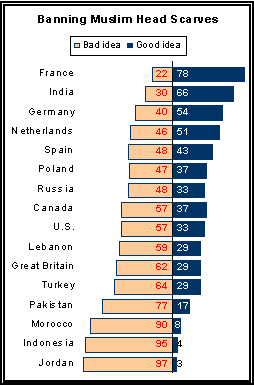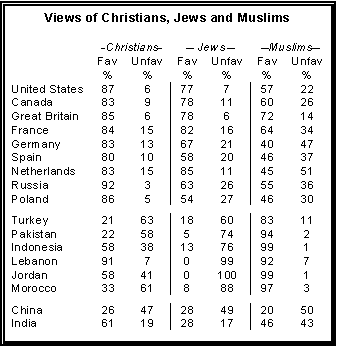A new international poll by the
Pew Global Attitude Project on
Islamic Extremism had three very interesting tables.
1. Islamic Extremism Threat Perception.
This table shows some very interesting findings with regards to the perception of that threat, and we all know that perception is really what matters. Surprisingly, the numbers in the US and in France are very similar.

2. Banning Muslim Head ScarvesMore findings show that France an India are the only countries vastly supporting the ban, followed by a

smaller majority in Germany, and the Netherlands.
All the other countries in the poll, including Turkey which incidently bans Muslim head scarves in public offices, think the bad is mostly a bad idea.
The US, Canada, Lebanon, Great Britain and Turkey hold similar views with analogous numbers.
3. Perception of Monotheist ReligionsThere is so much to say on these findings that I'll let you draw your own conclusions:


 smaller majority in Germany, and the Netherlands.
smaller majority in Germany, and the Netherlands.
3 Comments:
the jordans' and lebanese views of jews is terrifying and no historical or political reason should legitimate this perception.
Yes, their views are terrible. The fact that population of Jordan is mostly made of Palestinian 'refugees' may explain (yet not justify) a few things there.
As far as Lebanon is concerned, the Hamas is very popular among muslims there even though the Christian minority is probably less anti-Jewish. Thet would be interesting to be studied along religious lines...
While I disagree with the views (none of them are encouraging) I'm not terribly surprised by the numbers from Lebanon and Jordan on the third graphic. Lebanese (Muslim and otherwise) and Jordanians have not always had the best interactions with Israel: the Israeli invasion of Lebanon and multiple wars involving Jordan to name a few. Of course, the graphic is talking about Jews as a people group as opposed to the government of Israel which makes the numbers even more interesting. It would have been interesting to have included Israel on the list.
The numbers that stick out to me are China. Not surprising per say, but I would be interested in seeing what the numbers would have been 10-20 years ago.
Post a Comment
<< Home